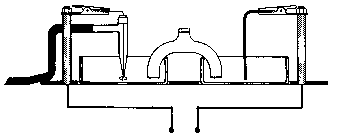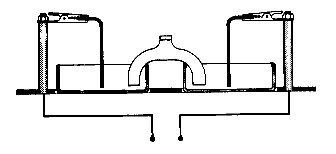Galvanic or Voltaic Cells
- Page ID
- 3002
\( \newcommand{\vecs}[1]{\overset { \scriptstyle \rightharpoonup} {\mathbf{#1}} } \)
\( \newcommand{\vecd}[1]{\overset{-\!-\!\rightharpoonup}{\vphantom{a}\smash {#1}}} \)
\( \newcommand{\id}{\mathrm{id}}\) \( \newcommand{\Span}{\mathrm{span}}\)
( \newcommand{\kernel}{\mathrm{null}\,}\) \( \newcommand{\range}{\mathrm{range}\,}\)
\( \newcommand{\RealPart}{\mathrm{Re}}\) \( \newcommand{\ImaginaryPart}{\mathrm{Im}}\)
\( \newcommand{\Argument}{\mathrm{Arg}}\) \( \newcommand{\norm}[1]{\| #1 \|}\)
\( \newcommand{\inner}[2]{\langle #1, #2 \rangle}\)
\( \newcommand{\Span}{\mathrm{span}}\)
\( \newcommand{\id}{\mathrm{id}}\)
\( \newcommand{\Span}{\mathrm{span}}\)
\( \newcommand{\kernel}{\mathrm{null}\,}\)
\( \newcommand{\range}{\mathrm{range}\,}\)
\( \newcommand{\RealPart}{\mathrm{Re}}\)
\( \newcommand{\ImaginaryPart}{\mathrm{Im}}\)
\( \newcommand{\Argument}{\mathrm{Arg}}\)
\( \newcommand{\norm}[1]{\| #1 \|}\)
\( \newcommand{\inner}[2]{\langle #1, #2 \rangle}\)
\( \newcommand{\Span}{\mathrm{span}}\) \( \newcommand{\AA}{\unicode[.8,0]{x212B}}\)
\( \newcommand{\vectorA}[1]{\vec{#1}} % arrow\)
\( \newcommand{\vectorAt}[1]{\vec{\text{#1}}} % arrow\)
\( \newcommand{\vectorB}[1]{\overset { \scriptstyle \rightharpoonup} {\mathbf{#1}} } \)
\( \newcommand{\vectorC}[1]{\textbf{#1}} \)
\( \newcommand{\vectorD}[1]{\overrightarrow{#1}} \)
\( \newcommand{\vectorDt}[1]{\overrightarrow{\text{#1}}} \)
\( \newcommand{\vectE}[1]{\overset{-\!-\!\rightharpoonup}{\vphantom{a}\smash{\mathbf {#1}}}} \)
\( \newcommand{\vecs}[1]{\overset { \scriptstyle \rightharpoonup} {\mathbf{#1}} } \)
\( \newcommand{\vecd}[1]{\overset{-\!-\!\rightharpoonup}{\vphantom{a}\smash {#1}}} \)
\(\newcommand{\avec}{\mathbf a}\) \(\newcommand{\bvec}{\mathbf b}\) \(\newcommand{\cvec}{\mathbf c}\) \(\newcommand{\dvec}{\mathbf d}\) \(\newcommand{\dtil}{\widetilde{\mathbf d}}\) \(\newcommand{\evec}{\mathbf e}\) \(\newcommand{\fvec}{\mathbf f}\) \(\newcommand{\nvec}{\mathbf n}\) \(\newcommand{\pvec}{\mathbf p}\) \(\newcommand{\qvec}{\mathbf q}\) \(\newcommand{\svec}{\mathbf s}\) \(\newcommand{\tvec}{\mathbf t}\) \(\newcommand{\uvec}{\mathbf u}\) \(\newcommand{\vvec}{\mathbf v}\) \(\newcommand{\wvec}{\mathbf w}\) \(\newcommand{\xvec}{\mathbf x}\) \(\newcommand{\yvec}{\mathbf y}\) \(\newcommand{\zvec}{\mathbf z}\) \(\newcommand{\rvec}{\mathbf r}\) \(\newcommand{\mvec}{\mathbf m}\) \(\newcommand{\zerovec}{\mathbf 0}\) \(\newcommand{\onevec}{\mathbf 1}\) \(\newcommand{\real}{\mathbb R}\) \(\newcommand{\twovec}[2]{\left[\begin{array}{r}#1 \\ #2 \end{array}\right]}\) \(\newcommand{\ctwovec}[2]{\left[\begin{array}{c}#1 \\ #2 \end{array}\right]}\) \(\newcommand{\threevec}[3]{\left[\begin{array}{r}#1 \\ #2 \\ #3 \end{array}\right]}\) \(\newcommand{\cthreevec}[3]{\left[\begin{array}{c}#1 \\ #2 \\ #3 \end{array}\right]}\) \(\newcommand{\fourvec}[4]{\left[\begin{array}{r}#1 \\ #2 \\ #3 \\ #4 \end{array}\right]}\) \(\newcommand{\cfourvec}[4]{\left[\begin{array}{c}#1 \\ #2 \\ #3 \\ #4 \end{array}\right]}\) \(\newcommand{\fivevec}[5]{\left[\begin{array}{r}#1 \\ #2 \\ #3 \\ #4 \\ #5 \\ \end{array}\right]}\) \(\newcommand{\cfivevec}[5]{\left[\begin{array}{c}#1 \\ #2 \\ #3 \\ #4 \\ #5 \\ \end{array}\right]}\) \(\newcommand{\mattwo}[4]{\left[\begin{array}{rr}#1 \amp #2 \\ #3 \amp #4 \\ \end{array}\right]}\) \(\newcommand{\laspan}[1]{\text{Span}\{#1\}}\) \(\newcommand{\bcal}{\cal B}\) \(\newcommand{\ccal}{\cal C}\) \(\newcommand{\scal}{\cal S}\) \(\newcommand{\wcal}{\cal W}\) \(\newcommand{\ecal}{\cal E}\) \(\newcommand{\coords}[2]{\left\{#1\right\}_{#2}}\) \(\newcommand{\gray}[1]{\color{gray}{#1}}\) \(\newcommand{\lgray}[1]{\color{lightgray}{#1}}\) \(\newcommand{\rank}{\operatorname{rank}}\) \(\newcommand{\row}{\text{Row}}\) \(\newcommand{\col}{\text{Col}}\) \(\renewcommand{\row}{\text{Row}}\) \(\newcommand{\nul}{\text{Nul}}\) \(\newcommand{\var}{\text{Var}}\) \(\newcommand{\corr}{\text{corr}}\) \(\newcommand{\len}[1]{\left|#1\right|}\) \(\newcommand{\bbar}{\overline{\bvec}}\) \(\newcommand{\bhat}{\widehat{\bvec}}\) \(\newcommand{\bperp}{\bvec^\perp}\) \(\newcommand{\xhat}{\widehat{\xvec}}\) \(\newcommand{\vhat}{\widehat{\vvec}}\) \(\newcommand{\uhat}{\widehat{\uvec}}\) \(\newcommand{\what}{\widehat{\wvec}}\) \(\newcommand{\Sighat}{\widehat{\Sigma}}\) \(\newcommand{\lt}{<}\) \(\newcommand{\gt}{>}\) \(\newcommand{\amp}{&}\) \(\definecolor{fillinmathshade}{gray}{0.9}\)Chemical Concepts Demonstrated
- Voltaic/galvanic cells, relative half-cell potentials
Demonstration


- One of the dishes is filled with ZnSO4 and the other with HCl.
- A strip of Zn metal is attached at one end to the posts of the electrochemistry template and is placed at the other end into the dish filled with Zn2+.
- The hydrogen electrode is attached, placed into the HCl solution, and H2 gas is bubbled in. Insert the salt bridge.
- The Zn2+/Zn half-cell is replaced with a Cu2+/Cu half-cell.
- The H+/H2 half-cell is replaced with a Zn2+/Zn. (picture 2)
Observations
The potential in the absence of the salt bridge is 0.00 V. After the salt bridge is inserted, the potential of the first set up is around + 0.76 V and the cell is a galvanic or voltaic cell. The Zn2+/Zn half-cell is the anode the H+/H2 is the cathode.
In the second set up, both the magnitude and the sign of the potential change. The potential is now roughly - 0.34 V.
Picture 2 shows the third set up. The potential is now - 1.10 V. If the leads are changed, the cell potential becomes + 1.10 V and the cell becomes a galvanic or voltaic cell.
Explanations (including important chemical equations)
With the leads connected so as to produce a cell potential of + 0.76 V, the half reactions are:
| anode: | Zn (s) ---> Zn 2+ (aq) + 2 e- | Eo = 0.76 V |
| cathode: | 2 H + (aq) + 2 e - ---> H2 (g) | Eo = 0.00 V |
| Zn (s) + 2 H + (aq) ---> Zn 2+ (aq) + H2 (g) | Eo cell = 0.76 V |
If the standard-state potential for the H+/H2 half-cell is assumed to be 0.00 V, and the potential for the anode half-reaction is equal in magnitude but opposite in sign to the standard-state potential for the Zn2+/Zn couple, then the standard-state reduction potential for the Zn2+/Zn half-cell must be - 0.76 V.
If the Zn2+/Zn half-cell is replaced with a Cu2+/Cu half-cell without reversing the leads to the voltmeter, the overall cell potential is - 0.34 V and the standard-state reduction potential for the Cu2+/Cu couple is therefore + 0.34 V.
| anode: | Cu (s) ---> Cu 2+ (aq) + 2 e- | Eo = - 0.34 V |
| cathode: | 2 H + (aq) + 2 e - ---> H2 (g) | Eo = - 0.00 V |
| Cu (s) + 2 H + (aq) ---> Cu 2+ (aq) + H2 (g) | Eo cell = -0.34 V |
If the H+/H2 half-cell is replaced with a Zn2+/Zn half-cell, the overall cell potential should be - 1.10V.
| anode: | Cu (s) ---> Cu 2+ (aq) + 2 e- | Eo = - 0.34 V |
| cathode: | Zn 2+ (aq) + 2 e- ---> Zn (s) | Eo = - 0.76 V |
| Cu (s) + Zn 2+ (aq) ---> Cu 2+ (aq) + Zn (s) | Eo cell = -1.10 V |
To set up a voltaic cell using these half reactions, one would have to reverse the leads to the voltmeter.
Contributors
- Dr. George Bodner (Perdue University)

